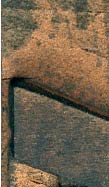|
|
||||||||||||||||||||
| introduction articles/lectures web typography style and design functions of type usability interaction composition webstyles bibliography links |
Typography, not as in 'the art of printing', but as in 'design and structure of visual communication using written language' remains the most effective way to communicate. Especially on the Internet. Many websites mainly use text and therefore typography. The balance between visual and textual based content is very important. As is the balance between style and design. This balance is ideally based on a concept and the main target audience. If designers were more involved in the concept they wouldn't feel the need as much to just 'copy-paste' a text in after the design is completed. Hopefully, redefining typography will make its role in new media design more prominent and less conventional. The form would follow the function more often. The result would be more usable and it would communicate more efficiently. After the 'shakeout' that destroyed the hype surrounding the Internet, it is even more important to find the real value and communicative strengths of the Web. Efficient use of type is vital for the success of the Internet as a global medium that communicates to a large target audience besides designers or technology minded people. So this is not merely a design issue; it is a social one as well. To create effective and usable sites, specially trained 'new media typographers' are required. They have to be educated in the principles of (new media) typography, interaction design and the usability guidelines. Graphic design becomes 'typographic communication design' with graphic styles applied to it. |
 |
||||||||||||||||||
 |
* Feel free to contact me if you want to share your thoughts on type/design. Design is not Art |
|||||||||||||||||||
© Copyright 2001 - 2005, Directiondesign - Jurriaan Schalken (info@directiondesign.nl)